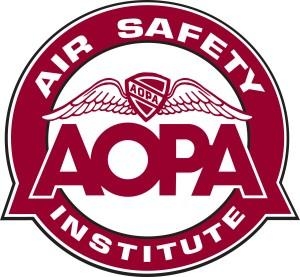Tue, Aug 25, 2015
The AOPA Air Safety Institute Has Issued A Safety Alert Regarding Midair Collision Avoidance
The Air Safety Institute Alert is of particular importance to recreational flyers because we fly at so many nontowered airports and most of our aircraft do not have collision avoidance systems installed. The alert message published by the Safety Institute repeats things we should already know, but it’s always good to review the basics.

The alert message says that although the frequency of midair collisions has seen a decrease over the past few years, there have been five in the past year that have resulted in loss of life. Last fall, an amateur-built Searey collided with a Cessna 172 in upstate New York, a Cessna 170 and a Skykits-Savannah collided in Nevada, and a Cirrus SR22 collided with a Robinson R22 helicopter in Maryland
This summer, a Cessna 150 and an F-16 collided in SC and, most recently, a Cessna 172 and a Sabreliner jet collided near San Diego, CA. While each accident has a specific set of circumstances and the NTSB is in the process of investigating, there are steps pilots can take to minimize the risks.
The following is a brief outline of things to be aware of and to watch out for:
- See and avoid continues to be the foundation for flying under visual flight rules. Pilots must be extra vigilant and constantly scan the airspace for traffic.
- Always fly on a designated VFR cruise altitude: Easterly–odd thousands plus 500 feet; Westerly–even thousands plus 500 feet.
- Request ATC’s VFR flight following service to the maximum extent possible.
- If your aircraft is equipped, ensure the transponder is always on to increase your aircraft’s electronic visibility.
- Consider equipping with ADS-B (both Out and In) so you can benefit from the increased situational awareness available with the Traffic Information Service-Broadcast (TIS-B).
- Consider installing an active traffic system or carry a portable traffic awareness product.
More than 50 percent of all midair collisions happen within 5nm of an airport—extra vigilance is required in the terminal area. The following are suggestions for increasing safety in this elevated area:
- At towered airports monitor the frequency and communicate early with the tower to gain situational awareness.
- At nontowered airports, broadcast your position and intentions no later than 10nm from the airport. Follow standard traffic pattern entry procedures, and broadcast your position and intentions on the common traffic advisory frequency in accordance with Section 4-1-9 of the Aeronautical Information Manual.
- Ensure aircraft landing lights, position lights, and anti-collision lights are on in the terminal area for maximum visibility.
- If carrying passengers, involve them in your traffic awareness process.
Midair collisions happen infrequently; however, when they occur, the chances for injury or death are substantial. To learn more about midair collision avoidance and to increase your safety margins, see the Air Safety Institute’s Collision Avoidance Spotlight at the link listed below.
More News
Terminal Radar Service Area Airspace surrounding designated airports wherein ATC provides radar vectoring, sequencing, and separation on a full-time basis for all IFR and participa>[...]
Very High Frequency (VHF) The frequency band between 30 and 300 MHz. Portions of this band, 108 to 118 MHz, are used for certain NAVAIDs; 118 to 136 MHz are used for civil air/grou>[...]
“From approximately November 2021 through January 2022, Britton-Harr, acting on behalf of AeroVanti, entered into lease-purchase agreements for five Piaggio-manufactured airc>[...]
Also: Virtual FLRAA Prototype, IFR-Capable Autonomous A/C, NS-32 Crew, Golden Dome Missile Defense Bombardier announced that the first production Global 8000 successfully completed>[...]
Aero Linx: The 1-26 Association (Schweizer) The Association’s goal is to foster the helpfulness, the camaraderie, and the opportunity for head-to-head competition that is fou>[...]
 ANN's Daily Aero-Term (05.29.25): Terminal Radar Service Area
ANN's Daily Aero-Term (05.29.25): Terminal Radar Service Area ANN's Daily Aero-Term (05.30.25): Very High Frequency (VHF)
ANN's Daily Aero-Term (05.30.25): Very High Frequency (VHF) Aero-News: Quote of the Day (05.30.25)
Aero-News: Quote of the Day (05.30.25) Airborne 05.23.25: Global 8000, Qatar B747 Accepted, Aviation Merit Badge
Airborne 05.23.25: Global 8000, Qatar B747 Accepted, Aviation Merit Badge ANN's Daily Aero-Linx (05.30.25)
ANN's Daily Aero-Linx (05.30.25)



